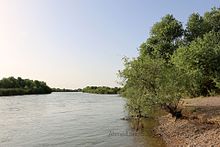Karkheh River


The Choaspes River (Iran) or Karkheh or Karkhen (Persian: کرخه) (perhaps the river known as the Gihon Ancient Greek: Γεῶν Book of Genesis 2:13 —one of the four Rivers of Paradise in the of Garden of Eden/Paradise in the Bible and as the river Choaspes Ancient Greek: Χοάσπης[1] in ancient times; also called Eulæus, in Ancient Greek: Εὔλαιος or Εὐλαῖος; Hebrew: אולי Ulai[2]) is a river in Khūzestān Province, in southwest Iran (ancient Susiana).
Description
The river rises in the Zagros Mountains, and passes west of Shush (ancient Susa), eventually falling in ancient times into the Tigris just below its confluence with the Euphrates very near to the Iran-Iraq border. In modern times, after approaching within 16 kilometres (10 mi) of the Dez River, it turns to the southwest and then, northwest of Ahvaz, turns northwest and is absorbed by the Hawizeh Marshes that straddle the Iran–Iraq border. Its peculiarly sweet water was sacred to the use of the Persian kings.[3] Ancient names for the Karkheh should be treated as conjectural because the bed of the river has changed in historic times, and because a nearby watercourse between the Karkheh and the Dez River, the Shaur, confuses the identification.[4]
The problem with the ancient names is that while the Karkheh flows a kilometre or two west of Susa, another major watercourse flows parallel to the Karkheh within a few kilometres east of Susa. When these rivers are in flood stage, the entire area south of Susa can be flooded, as the waters of the two watercourses mingle. The watercourse a kilometre or two east of Susa, now called the Shaur, flows east between the Haft Tepe and Shaur ridges into the Dez River, north of where the Dez and Karun rivers merge. At some previous time, the Karkheh may have joined the eastern end of the Shaur. The timing of these changes is not known with any certainty. The ancient name of the Shaur may have been the Choaspes.
The river is mentioned in the Bible, Book of Daniel 8:2,16,[5][6] and should not be confused with the Choaspes River in modern-day Afghanistan, which flows into the Indus.
The river is currently the location of the Karkheh Dam and hydro-power plant in Iran.[7]
See also
Notes and references
- ^ Bosworth, A. B. (1993). Conquest and Empire: The Reign of Alexander the Great. Cambridge University Press. p. 88. ISBN 0-521-40679-X.
- ^ Potts, Daniel T. (1999). The Archaeology of Elam: Formation and Transformation of an Ancient Iranian State. Cambridge University Press. p. 236. ISBN 0-521-56496-4.
One refers to his camp while on campaign and to action near the Ulai, the modern Karkheh river, in Khuzistan
- ^ Hazlitt, William (1851). "page 108". The Classical Gazetteer. Archived from the original on 2007-03-03.
- ^ John Hansman, "Charax and the Karkheh," Iranica Antiqua VII(1967), pp.21-58, and Michael J. Kirkby, "Land and Water Resources of the Deh Luran and Khuzistan Plains," Appendix I, in Studies in the Archaeological History of the Deh Luran Plain. The Excavation of Chagha Sefid, edited by Frank Hole, pp. 251-288. Memoirs, no. 9, Ann Arbor, Museum of Anthropology, University of Michigan
- ^ "In the third year of the reign of king Belshazzar a vision appeared unto me, even unto me Daniel, after that which appeared unto me at the first. And I saw in the vision; now it was so, that when I saw, I was in Shushan the palace, which is in the province of Elam; and I saw in the vision, and I was by the river Ulai." (Daniel, 8:2)
- ^ "And I heard a man's voice between the banks of Ulai, which called, and said, Gabriel, make this man to understand the vision." (Daniel, 8:16)
- ^ "Economic news in brief (Apr. 9)". Mehr News Agency. 2006-04-09. Retrieved 2008-07-30.[permanent dead link]
External links
- Choaspes (Karkheh), Photographs of the river: Livius.
- Karkheh river marshes, BirdLife IBA Factsheet, BirdLife International.
